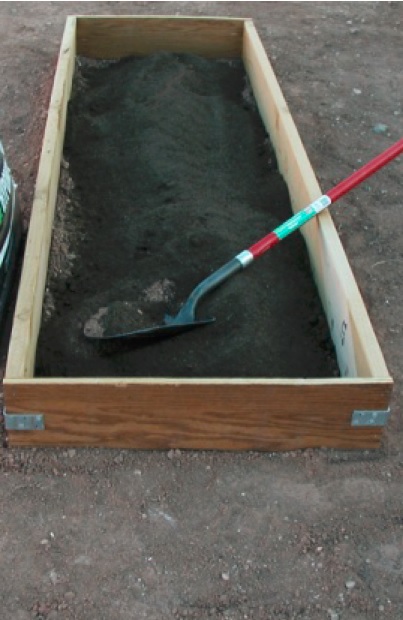 Raised Bed Gardening - December 30, 2015 Jeff Schalau, Agent, Agriculture & Natural Resources University of Arizona Cooperative Extension, Yavapai County The rockiness and steep slopes of the Verde Valley’s upland areas can make it very challenging to grow annual flowers and vegetables. Where soils do exist, rocks can be removed and the soil amended, but often, the amount of rock or the presence of shallow bedrock make this very challenging. Here, gardeners have little other choice than to use containers and/or raised beds. Although there will be initial expense and labor in constructing walls for raised beds, the finished product should last for many years and allow for deep soil amendment. The choice of framework for walls depends on the availability and expense of the construction material, as well as the desired appearance of the final product in the landscape. Naturally rot-resistant lumber, such as redwood or cedar, may also be used. If you have an ample supply of native rock onsite, it can be dry-stacked or mortared together. Other possibilities include concrete blocks, bricks, or synthetic lumber made of recycled plastic. National gardening publications have raised concerns about the safety of using treated lumber for raised beds in food gardens. The US Environmental Protection Agency phased out the consumer/residential use of lumber treated with arsenic containing compounds in 2003 and those treatments have been modified to use copper containing compounds. After reviewing the available information, I would recommend that copper treated lumber be avoided for use in raised beds used for food production. Similar concerns exist for creosote and the use of railroad ties for use in raised beds for food production. Here, it is thought that older railroad ties can be used. However, injury may occur if ties are still oozing black, sticky creosote or smell intensely. Here, you may attach a heavy plastic liner between the creosote and soil. Raised beds can vary depending on the gardener's goals and the topography. Hillside terraces may require different bed dimensions than those used for flat-land vegetable gardens. On hillsides, follow the contour of the land and adjust the depth of beds according to the slope of the hill. On flat ground, you can be more creative. Make sure pathways are wide enough to allow wheelbarrow and/or wheelchair access depending on your goals and needs. My garden is on a gentle slope and uses a 25’ x 18’ perimeter wall of dry-stacked granite that was gathered onsite to create one large terrace. A convenient width to use for raised beds is 4 feet. Here, the center of the bed is accessible from either side. Lumber for constructing beds is readily available in 4-foot length multiples, minimizing the amount of sawing necessary and the amount of waste produced during construction. If the bed is accessible only from one side, limit the width to 3 feet. Most gardeners find it uncomfortable to reach farther than 3 feet to tend the bed. Bed height can vary, but 18 to 24 inches is fairly common. The length of a raised bed is not critical. However, you should divide long distances into shorter beds (24 feet is probably a good maximum length). Three foot wide walkways are usually adequate. These can be mulched with wood chips to minimize weeds. After you have built your raised beds, you are faced with finding suitable soil to fill it. This can be a difficult decision and quality topsoil may can be challenging to locate and expensive. Bagged products often contain lots of organic materials and lack actual mineral soil. I would avoid bagged products. I strongly recommend using mineral soil that is free of weeds and has a silty or sandy texture. This should be amended with organic matter (compost) and other nutrients (do a soil test to determine specific needs). Remember to construct enough bed space to allow for crop rotation. Crops of certain plant families need to be rotated with crops in other families to avoid increasing the incidence of disease and other pests. You cannot have one small raised bed filled with tomatoes and peppers every year without eventually running into disease issues. Other considerations for successful raised bed gardening are: at least six hours (more is better) of sun per day, access to water for irrigation, perennial weed control, fencing to prevent undesirable wildlife intrusions, hardware cloth to limit gopher access, and hoops to support plastic or floating row cover to extend the growing season. For additional information about raised beds, I have included links to several publications on the web version of this column. Follow the Backyard Gardener on Twitter – use the link on the BYG website. If you have other gardening questions, call the Master Gardener help line in the Camp Verde office at 928-554-8992 or e-mail us at verdevalleymg@gmail.com and be sure to include your name, address and phone number. Find past Backyard Gardener columns or provide feedback at the Backyard Gardener web site: http://cals.arizona.edu/yavapai/anr/hort/byg/. Additional Resources Building a Raised Bed Garden Texas A & M Agrilife Extension aggie-horticulture.tamu.edu/vegetable/files/2010/10/E-560_raised_bed_garden.pdf Raised Bed Gardening Utah State University Cooperative Extension extension.usu.edu/htm/publications/file=14497 Raised Bed Gardening University of Missouri Extension extension.missouri.edu/p/G6985 Gardening in Small Spaces University of Maine, also shows season extension techniques. umaine.edu/publications/2761e/ |